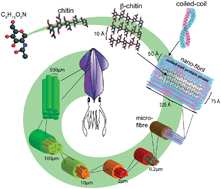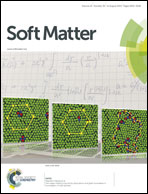Hierarchical, self-similar structure in native squid pen
Abstract
The structure of native squid pen (gladius) was investigated in two different species on different length scales. By combining microscopy, atomic force microscopy (AFM), and X-ray diffraction, the experiments probed length scales from millimetres down to nanometres. The gladii showed a hierarchical, self-similar structure in the optical experiments with fibres of different size oriented along the long axis of the gladius. The fibre-like structure was reproduced at the nanoscale in AFM measurements and fibres with diameters of 500 μm, 100 μm, 10 μm, 2 μm and 0.2 μm were observed. Their molecular structure was determined using X-ray diffraction. In the squid gladius, the chitin molecules are known to form nano-crystallites of monoclinic lattice symmetry wrapped in a protein layer, resulting in β-chitin nano-fibrils. Signals corresponding to the α-coil protein phase and β-chitin crystallites were observed in the X-ray experiments and their orientation with respect to the fibre-axis was determined. The size of a nano-fibril was estimated from the X-ray experiments to be about 150 × 300 Å. About 100 of these nano-fibrils are needed to form a 0.2 μm thick micro-fibre. We found that the molecular structure is highly anisotropic with ∼90% of the α-coils and β-chitin crystallites oriented along the fibre-axis, indicating a strong correlation between the macroscale structure and molecular orientation.


 Please wait while we load your content...
Please wait while we load your content...